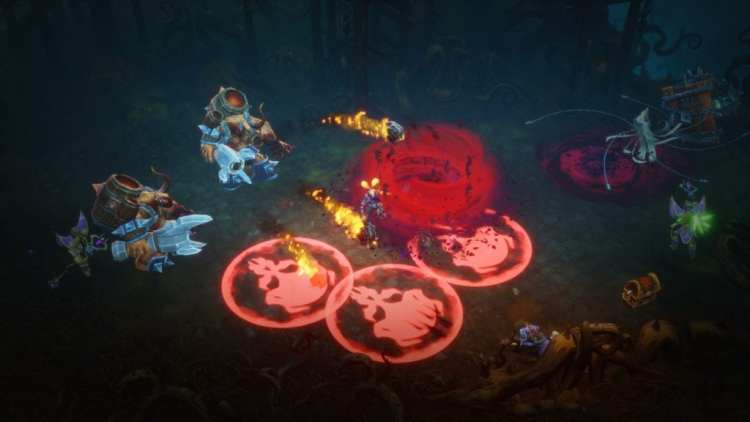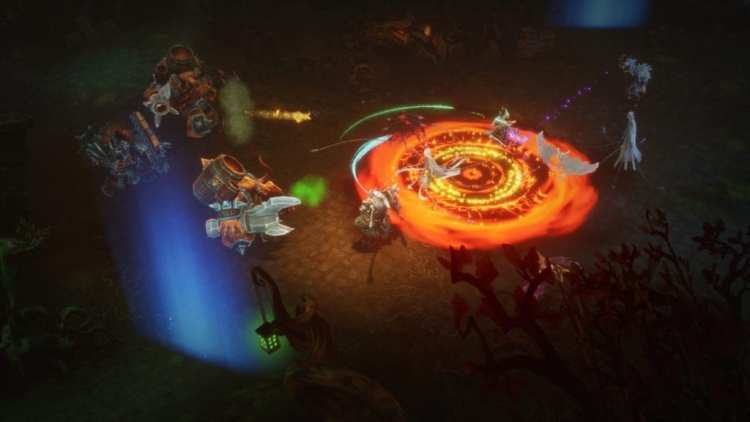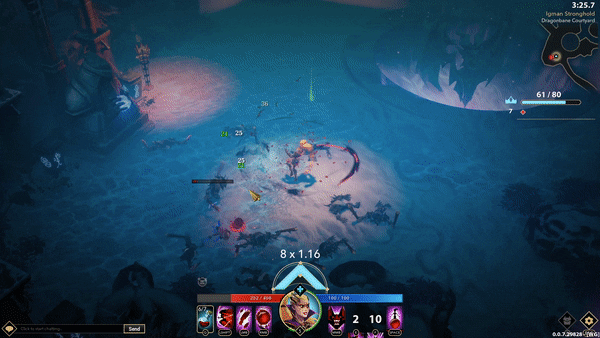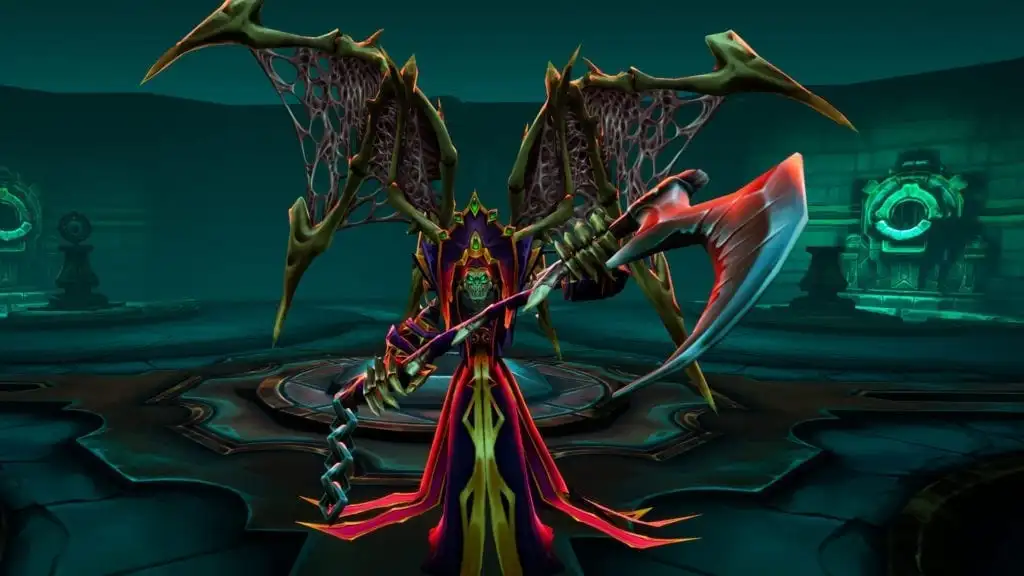Playing Pagan Online may feel instantly familiar to fans of action role-playing games such as Diablo. A group of heroes with specialized talents enter darkened dungeons to battle a variety of evil creatures, culminating in a boss battle. The core difference is that this Wargaming-published title takes place in a fantasy universe inspired by pre-Christian Slavic lore, which the game’s Serbian developer Mad Head Games grew up hearing.
Skillfully Hacking And Slashing
At its core, Pagan is a game about a family of heroes. Right now, there are five characters available, with three more in development. Each character has a total of eight skills that players can improve individually. The developers drew inspiration from existing action-RPG archetypes to build characters that feel familiar while possessing some unique twists.
For example, the first character I saw was Lukian, who is an elemental caster with numerous area-of-effect moves. His elements can be toggled between fire or lightning moves with a click of the mouse, which gives the character a great deal of versatility. It’s almost like having two characters in one. He’s also fast for a spell caster and can quickly jump in to lay down tons of damage on mobs.

Other characters include the berserker Kingewitch; Istok, the tank who carries a giant hammer; and the mystical whip-wielding Anya. Each caters to specific play styles, so players can choose the one that best suits them when entering the world.
Everyone starts in the Pantheon, which acts as both the social hub and marketplace where players can craft new items and trade. Each Pantheon instance supports 50 people at a time, and you can fully customize characters with different outfits, emotes, banners, and pets. After socializing for a bit, players can access the world map and jump straight into missions.
Entering Pagan Online
The game divides its main campaign into different Acts that players may access in a semi-linear progression. Completing missions and levelling up unlocks new areas and characters. The level cap currently sits at 30, but the devs have designed the content with a strong focus on replayability.
Narrative levels support multiple modes including survival, defense, and expedition complemented with three levels of difficulty. You’ll find the best loot in these extra game modes, with the story campaign purposefully made easier for those who just want to enjoy the narrative. Similar to games like Destiny, the player’s gear contributes to an overall power rating. This may determine your chances of survival at higher difficulty settings.
“This is not the kind of game that you can play with the monitor off and wait for the sound of the enemies to stop,” said Pagan Online product director Jacob Beucler, remarking on the game’s difficulty. Enemy groups tend to attack quickly, so players must work just as fast to keep foes from overwhelming them. With some characters, activating a skill will reduce the cooldown for others, encouraging non-stop action.

Pagan has optimized its controls for the mouse and keyboard. But instead of having a one-click for everything scheme, it uses WASD for movement like a top-down shooter would. It takes a little adjusting to if you’re used to having both attack and movement controlled by mouse. Still, it only took me a minute or two to become accustomed to it. Mad Head Games co-founder Uros Banjesevic explained that the WASD setup offered better mobility while shifting the focus from “numbers and gear” to showcasing the player’s skill.
The emphasis on skill is further underscored by how players may only have seven health potions on them. Breaking objects and killing monsters might get you more, but players will still need to keep a close eye on their health. That’s especially true since health won’t regenerate outside of combat without the use of specific skills or gear.
Although some elements of Pagan – such as creature encounters – are procedurally generated, the levels are mainly hand-crafted and relatively fixed. The game features four different biomes ranging from frosty ice zones to fiery underworlds. The look and feel can get a little Diablo-like, but the game manages to establish its own identity. For example, there’s a Golden Chicken, which is the reverse version of the loot goblin. You have to protect the fragile creature and avoid killing it yourself during an encounter for it to lay a golden egg full of valuable loot.
Whipping It
I chose to play as Anya, a “Blood Ritualist” who commands blood magic spells and carries a powerful whip. Although I originally thought that she was a short-range character, given her weapon, she turned out have an extensive reach. I could hit enemies from across the screen. That turned her into a powerful character both up-close and from afar. Anya is also a very beginner-friendly character because her attacks can extract health from fallen enemies by creating blood shards.
Special attacks map to the F, E, and Spacebar keys. Anya’s moves include a spinning attack, conjuring a whirlwind that damages everything in its area, and a spell that summons a giant “death heart” that will explode to damage and debuff enemies caught in its blast radius. Attacking the death heart will prolong the timer while making the blast stronger. However, the challenge lies in keeping enemies close to it long enough for this to be worthwhile. She can also launch a skill shot that damages a line of enemies, leaving a trail of blood shards behind.

Engaging enemies will create barriers, effectively locking both players and foes inside a temporary arena. So, there’s little chance to flee and use entryways and chokepoints to massacre monsters. This kept me focused on using offensive strategies. I soon mastered the art of luring creatures into my traps for my whirlwind, using my skill shot as a follow-up move. The exploding heart has a long cooldown, and I had trouble getting enemies to stand still long enough for it to go off, so I didn’t use it much.
Not relying on the one-click combat and number keys for everything took a little getting used to, but it wasn’t too bad of a switch. However, Anya’s main attacks are one-click per hit as opposed to holding down the mouse button for a sustained assault. That’s fine for a short demo, but part of me wondered how long it would take before that became tiring. Fortunately, it seems some other characters will have click-and-hold attacks.
My demo concluded with a mini-boss battle, which is usually one of the dungeon’s minions pumped up with higher stats and possibly some additional abilities.
Action Without Microtransactions
Pagan Online is set to launch as a premium game like Diablo, meaning that players will be able to dive into the action without worrying about microtransactions blocking progression or other aspects of the experience. At the same time, Mad Head plans to continually support the game with additional content and characters down the road.
The pre-Christian mythology offers a subtle differentiation from other action RPGs. At the end of the day, players will still be fighting familiar hordes of goblins, ogres, and sorcerers. However, there won’t be angels and demons involved. The story instead involves several gods who helped create the universe and have mysteriously vanished. It’s up to the player to learn what happened and restore balance to the world by restoring the lost deities. That’s the story at launch, but there’s the possibility of extending to other world mythologies as the game’s development progresses.
Pagan is currently in its testing phases. It will support two players in co-op play when it launches in Early Access in April. The goal, though, is to support larger party sizes as development continues. Banjesevic confirmed that the studio has a great deal planned for the game. However, it will be Early Access players who determine the game’s course.
Although premium online role-playing games are becoming an increasingly crowded space – with the launch of Anthem, the coming release of The Division 2, and the recent content update for Destiny 2 being just a few examples – they’re all loot-based shooters. Mad Head and Wargaming see the fantasy hack’n’slash RPG genre as a relatively underserved space. And so they’re bringing a game that offers a fresh take on the genre with an emphasis on player skill.
Play sessions can be as short as ten minutes for players who want to quickly jump in, climb the leaderboard, level up, and grab some loot. Of course, players who want to experience the story can do longer sessions without the worry of running into paywalls. As a service, supporting Pagan Online with new content should keep players hacking and slashing for a long time to come.







Published: Mar 11, 2019 02:00 pm